News
The Big P: The Lack of Full Frontal Male Nudity in Horror
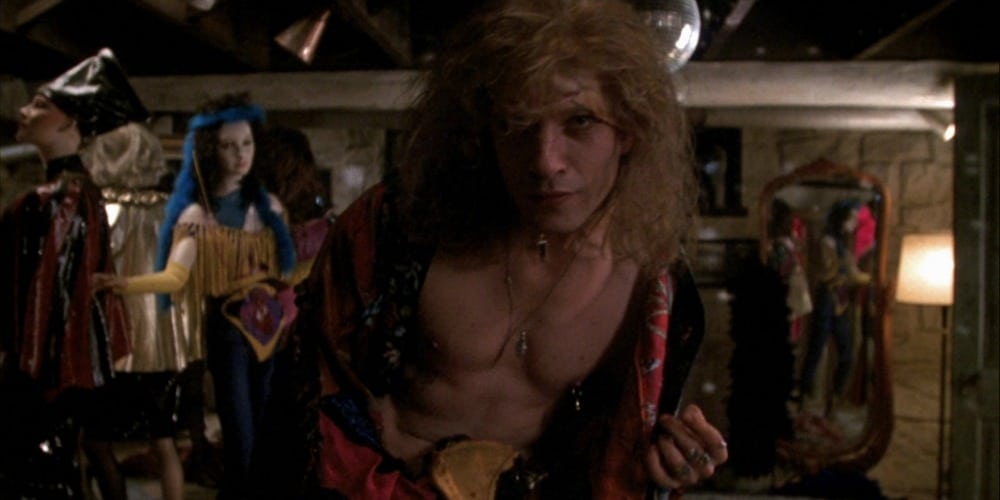
In his 2011 book How to Survive a Horror Movie, Seth Grahame-Smith notes:
“When the Devil has you at claw’s length, you need something shocking. Something dramatic. Something that will make the entire Terrorverse collapse in on itself. And there’s only one object with that much power: A Penis.”
When I first read that line I nearly laughed myself to death, but the next section got me thinking.
“Full frontal male nudity (P) does not exist in the Terrorverse (T),” the author explained. “Therefore, if P is present, T cannot be present. And if T is present, P cannot be present…It may seem like a juvenile response to a desperate situation. A sad attempt to mask fear with immature humor. Maybe it is. But would you rather die with dignity or live with nudity?”
There it was; a keen observation spelled out with humor and hidden in satire.
I have often pondered why full frontal male nudity is such a rarity in film. Even in horror, a genre known for pushing boundaries, female nudity is not only accepted but expected while the appearance of a penis almost never happens.
I wish that I could say it was shocking, but this precedent was set long ago and fostered by an entire industry.
In 1892, Thomas Edison created the first ever motion picture camera. By 1897, the first erotic film After the Ball by George Méliès had made its way to the screen featuring simulated female nudity, and only two years later, the first woman appeared fully nude on screen in Le Coucher de la Mariée.
It had taken just under seven years for women to be on full display in this daring new art form, and while dozens of erotically charged films were made in the following decade, it would be another 12 years before full frontal male nudity in the briefest of glimpses would follow suit in Francesco Bertolini’s terrifying, surreal adaptation of Dante’s Inferno.
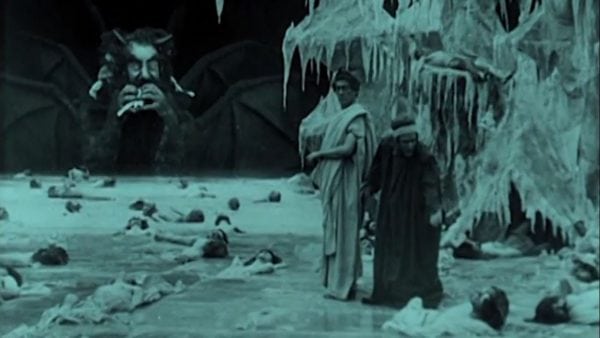
L’Inferno (1911) by Franceso Bertolini was the first film to include full frontal male nudity
As years went by, this disparity continued and the chasm between male and female nudity grew. The Hays Code for film “decency” came and went and by that time, the lines were clearly drawn.
The female form in its entirety was an object to be sexualized and eroticized at every opportunity, while the male form was locked away in obscurity and shadow except to prove his masculinity or in the use of the penis as either a joke or to shock the audience.
To paraphrase Australian comedian Hannah Gadsby, filmmakers had found a new way of creating flesh-vases for their dick-flowers.
Allow me to give you a real-life example.
Last year, I attended a crowded, highly-anticipated screening of Adam Green’s Victor Crowley at Nightmares Film Festival. In the film, Andrew (Parry Shen) was hosting a book signing, engaging in all-too-awkward conversation with fans.
A gorgeous, busty woman stepped up and asked him to sign her breast to the sound of more than a few appreciative whoops and whistles from the audience, which she eagerly shoved into his face. He licked his lips and nearly fell over himself taking his time with that signature.
After a few moments, she finally walks away to be replaced with an older gentleman who proceeded to pull his penis out of his pants, plop it on the desk, and ask for the same treatment.
For about 2.5 seconds, the audience sat in stunned silence before nervous giggles gave way to riotous laughter as Andrew backed away and stammered out a vehement refusal.
There it was. That audience and their reaction became a representative microcosm for horror audiences at large.
I have pondered this and similar reactions for a number of years.
I remember asking a film professor in college why male nudity, especially involving the penis, was so rare in film in general. In reply, he told me that the penis was an outward, inherently sexual organ so where women can be shown, fully nude, without ever including the actual sexual organs, men can not.
This answer partially mollified me as a student, but it only sent me looking for more answers.
It was clear to me that female nudity in film was predominantly about sexualizing those women. Every part of the anatomy has been re-purposed to appease and please the male gaze whether the “organs” are sexual or not.
This is not to say that men are never objectified in film. Certainly, anyone who has ever seen any of David DeCoteau’s gloriously decandent homoerotic films will agree. However, it always seems that more is required of a woman in her objectification.
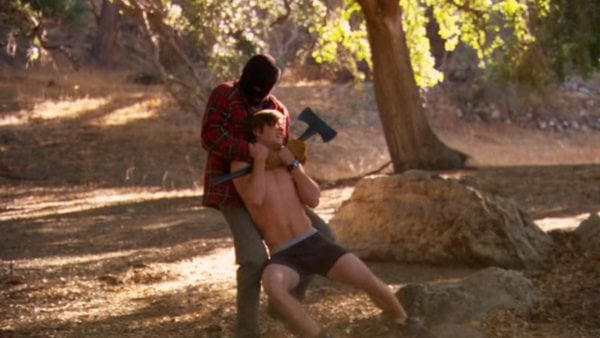
Director David Decoteau has often turned the male gaze to men rather than women placing male actors in situations reserved for women in the genre.
After all, for most men in film, all that’s required is baring their ass for the camera.
Don’t believe me? I’d like you to turn your attention to Brian de Palma’s 1976 classic Carrie, and more specifically that opening scene.
There they are. All of those high school students (whose characters would, for the most part, be underage even if the actresses were not) frolicking in the locker room and more than one fully exposed to the camera.
The soft pink lighting, which I’m almost positive was supposed to convey a dream-like innocence to the entire scene, did little to take away from the fact that a room full of women were completely naked and fully exposed to the cameras. If anything, it only heightened that feeling.
Flash forward to another locker room.
In 1985’s A Nightmare on Elm Street 2: Freddy’s Revenge, Jesse (Mark Patton) found himself trapped in a locker room by Coach Schneider (Marshall Bell). It’s pretty clear that Schneider intended to rape Jesse to anyone who is paying remote attention to what is going on here.
Jesse is tied up, completely at the coach’s mercy or so we think. It’s the coach, however, who, when totally naked, finds himself a victim. Yet, even in that most vulnerable moment in the shower, we only see him heavily shadowed or from behind.
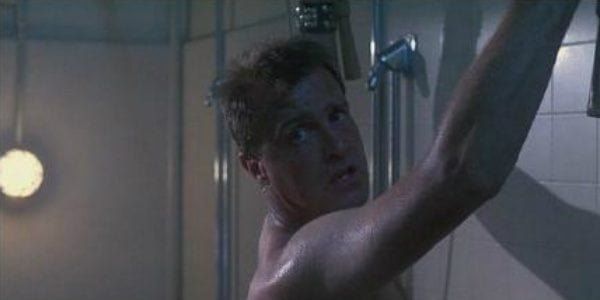
Coach Schneider (Marshall Bell) died a horrible death in the shower in A Nightmare on Elm Street 2: Freddy’s Revenge but even here full frontal male nudity was not required.
This is not to say full frontal male nudity is a complete stranger to genre filmmaking, but when it has happened, especially in the past, it seemed to be filmed through an entirely different lens than female nudity.
The first time I ever saw an actor fully nude for all the world to see was in 1981’s classic Ghost Story based on the novel by Peter Straub when Craig Wasson’s character plummeted to his death. I remember rewinding the VHS copy of the film to make sure that what I thought I saw was actually there.
And who can forget the shocking reveal that Angela had been male the entire time at the end of Sleepaway Camp?
In these instances there is no overt sexuality. Wasson’s penis was simply there as he flailed to his death and Angela’s was meant only to shock the audience. (Honestly, that’s only the beginning of my issues with the final scenes of Sleepaway Camp, but we’ll have to get into that in another article.)
This brings us to another point: a great deal of time when a man goes full frontal, especially in studio films, a prosthetic penis is used in place of the actor’s own member. As a matter of fact, there’s an entire business built around making these specialized prostheses.
Most studio execs, directors, actors, etc. will reassure you that it’s not due to lack of confidence on an actor’s part, but instead because they want a specific “look” for the film.
Seriously?
One has to question, in the face of this knowledge, how many women are offered a body double or really any other option to avoid being naked and fully exposed to a camera crew and later to the world audience?
In more recent years, the big P has begun to appear more often in more “art haus” and stylized horror films.
The demon Paimon was on full display, though again slightly in shadow, in this year’s Hereditary, and no few of his followers, both male and female, followed suit in the film’s final scene.
Likewise, anyone who has seen the recent Nicholas Cage film, Mandy, will be hard-pressed to forget Linus Roache opening his robe to offer Andrea Riseborough’s Mandy the privilege of having sex with him.
This was one of the closest examples I’ve seen to truly sexualized male frontal nudity. For the briefest of moment’s that familiar gaze, so often turned upon women, sees Roache fully.
One has to question if that’s the answer to this inequality, however.
Should men be required to bare all for the camera to balance this scale? Woudn’t it be more prudent to simply require less nudity from actresses in film? Is objectifying anyone okay?
I tend to believe that objectification is rarely justified. I’m not sure that in this case, however, actors don’t owe actresses a solid on this one. Perhaps it’s time for them to step up to the plate and put the P on display.
'Civil War' Review: Is It Worth Watching?
Follow our new YouTube channel "Mysteries and Movies" here.

Lists
Thrills and Chills: Ranking ‘Radio Silence’ Films from Bloody Brilliant to Just Bloody
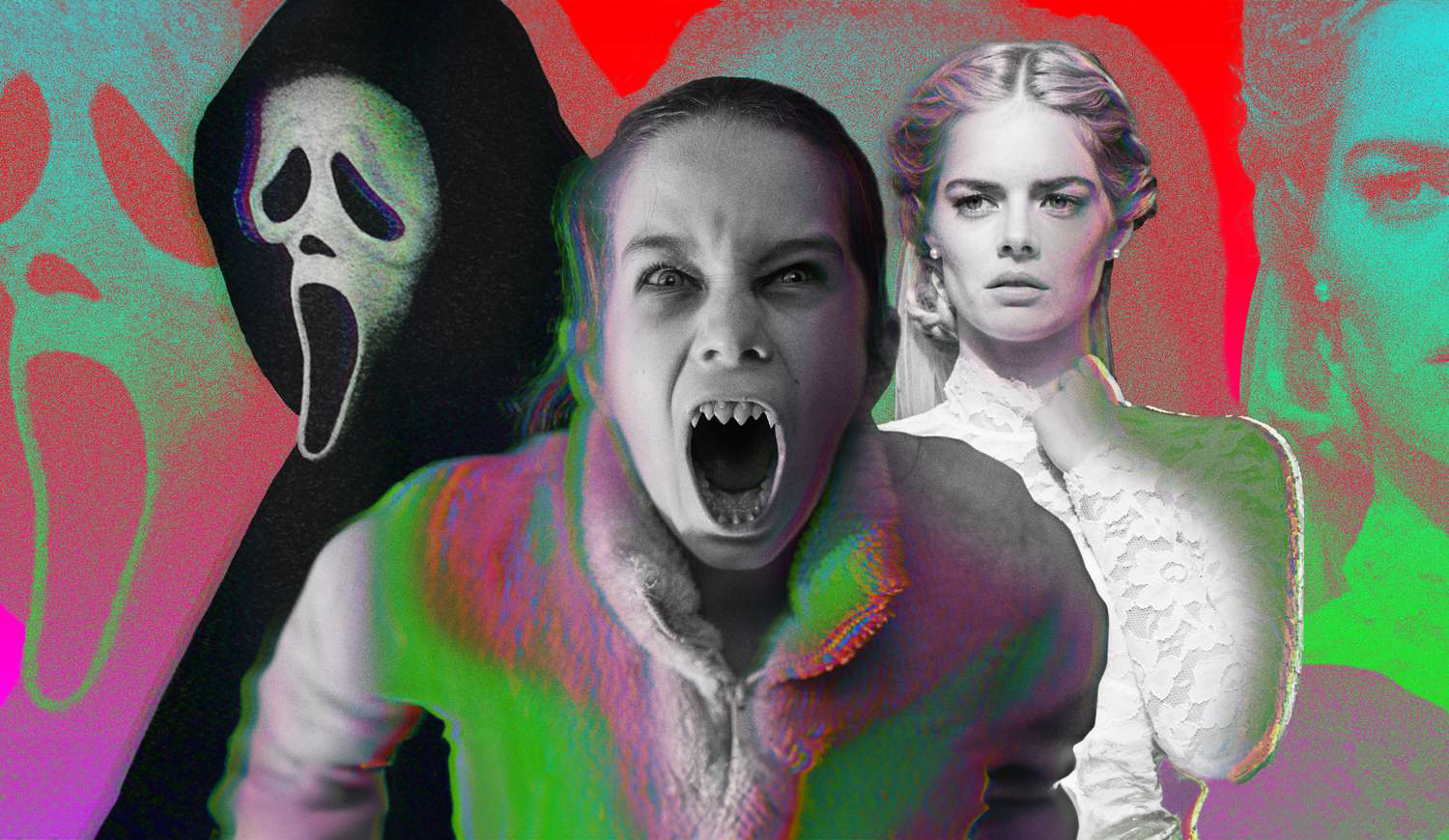
Matt Bettinelli-Olpin, Tyler Gillett, and Chad Villella are all filmmakers under the collective label called Radio Silence. Bettinelli-Olpin and Gillett are the primary directors under that moniker while Villella produces.
They have gained popularity over the past 13 years and their films have become known as having a certain Radio Silence “signature.” They are bloody, usually contain monsters, and have breakneck action sequences. Their recent film Abigail exemplifies that signature and is perhaps their best film yet. They are currently working on a reboot of John Carpenter’s Escape From New York.
We thought we would go through the list of projects they have directed and rank them from high to low. None of the movies and shorts on this list are bad, they all have their merits. These rankings from top to bottom are just ones we felt showcased their talents the best.
We didn’t include movies they produced but didn’t direct.
#1. Abigail
An update to the second film on this list, Abagail is the natural progression of Radio Silence’s love of lockdown horror. It follows in pretty much the same footsteps of Ready or Not, but manages to go one better — make it about vampires.
#2. Ready or Not
This film put Radio Silence on the map. While not as successful at the box office as some of their other films, Ready or Not proved that the team could step outside their limited anthology space and create a fun, thrilling, and bloody adventure-length film.
#3. Scream (2022)
While Scream will always be a polarizing franchise, this prequel, sequel, reboot — however you want to label it showed just how much Radio Silence knew the source material. It wasn’t lazy or cash-grabby, just a good time with legendary characters we love and new ones who grew on us.
#4 Southbound (The Way Out)
Radio Silence tosses their found footage modus operandi for this anthology film. Responsible for the bookend stories, they create a terrifying world in their segment titled The Way Out, which involves strange floating beings and some sort of time loop. It’s kind of the first time we see their work without a shaky cam. If we were to rank this entire film, it would remain at this position on the list.
#5. V/H/S (10/31/98)
The film that started it all for Radio Silence. Or should we say the segment that started it all. Even though this isn’t feature-length what they managed to do with the time they had was very good. Their chapter was titled 10/31/98, a found-footage short involving a group of friends who crash what they think is a staged exorcism only to learn not to assume things on Halloween night.
#6. Scream VI
Cranking up the action, moving to the big city and letting Ghostface use a shotgun, Scream VI turned the franchise on its head. Like their first one, this film played with canon and managed to win over a lot of fans in its direction, but alienated others for coloring too far outside the lines of Wes Craven’s beloved series. If any sequel was showing how the trope was going stale it was Scream VI, but it managed to squeeze some fresh blood out of this nearly three-decade mainstay.
#7. Devil’s Due
Fairly underrated, this, Radio Silence’s first feature-length film, is a sampler of things they took from V/H/S. It was filmed in an omnipresent found footage style, showcasing a form of possession, and features clueless men. Since this was their first bonafide major studio job it’s a wonderful touchstone to see how far they have come with their storytelling.
'Civil War' Review: Is It Worth Watching?
Follow our new YouTube channel "Mysteries and Movies" here.
News
Perhaps the Scariest, Most Disturbing Series of The Year

You may have never heard of Richard Gadd, but that will probably change after this month. His mini-series Baby Reindeer just hit Netflix and it’s a terrifying deep dive into abuse, addiction, and mental illness. What is even scarier is that it’s based on Gadd’s real-life hardships.
The crux of the story is about a man named Donny Dunn played by Gadd who wants to be a stand-up comedian, but it’s not working out so well thanks to stage fright stemming from his insecurity.
One day at his day job he meets a woman named Martha, played to unhinged perfection by Jessica Gunning, who is instantly charmed by Donny’s kindness and good looks. It doesn’t take long before she nicknames him “Baby Reindeer” and begins to relentlessly stalk him. But that is just the apex of Donny’s problems, he has his own incredibly disturbing issues.
This mini-series should come with a lot of triggers, so just be warned it is not for the faint of heart. The horrors here don’t come from blood and gore, but from physical and mental abuse that go beyond any physiological thriller you may have ever seen.
“It’s very emotionally true, obviously: I was severely stalked and severely abused,” Gadd said to People, explaining why he changed some aspects of the story. “But we wanted it to exist in the sphere of art, as well as protect the people it’s based on.”
The series has gained momentum thanks to positive word-of-mouth, and Gadd is getting used to the notoriety.
“It’s clearly struck a chord,” he told The Guardian. “I really did believe in it, but it’s taken off so quickly that I do feel a bit windswept.”
You can stream Baby Reindeer on Netflix right now.
If you or someone you know has been sexually assaulted, please contact the National Sexual Assault Hotline at 1-800-656-HOPE (4673) or go to rainn.org.
'Civil War' Review: Is It Worth Watching?
Follow our new YouTube channel "Mysteries and Movies" here.
Movies
The Original ‘Beetlejuice’ Sequel Had an Interesting Location
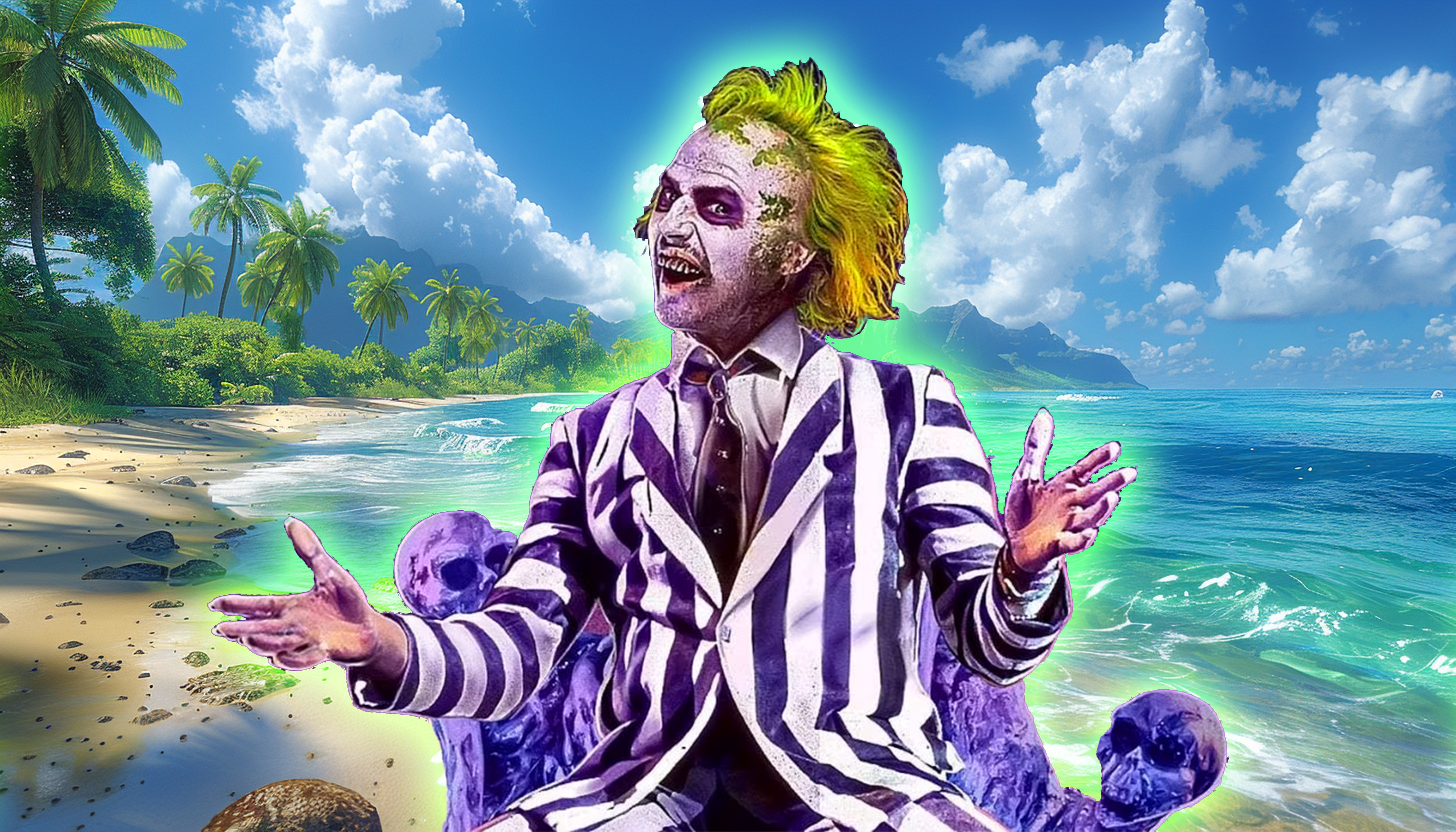
Back in the late ’80s and early ’90s sequels to hit movies weren’t as linear as they are today. It was more like “let’s re-do the situation but in a different location.” Remember Speed 2, or National Lampoon’s European Vacation? Even Aliens, as good as it is, follows a lot of the plot points of the original; people stuck on a ship, an android, a little girl in peril instead of a cat. So it makes sense that one of the most popular supernatural comedies of all time, Beetlejuice would follow the same pattern.
In 1991 Tim Burton was interested in doing a sequel to his 1988 original, it was called Beetlejuice Goes Hawaiian:
“The Deetz family moves to Hawaii to develop a resort. Construction begins, and it’s quickly discovered that the hotel will be sitting on top of an ancient burial ground. Beetlejuice comes in to save the day.”
Burton liked the script but wanted some re-writes so he asked then-hot screenwriter Daniel Waters who had just got done contributing to Heathers. He passed on the opportunity so producer David Geffen offered it to Troop Beverly Hills scribe Pamela Norris to no avail.
Eventually, Warner Bros. asked Kevin Smith to punch up Beetlejuice Goes Hawaiian, he scoffed at the idea, saying, “Didn’t we say all we needed to say in the first Beetlejuice? Must we go tropical?”
Nine years later the sequel was killed. The studio said Winona Ryder was now too old for the part and an entire re-cast needed to happen. But Burton never gave up, there were a lot of directions he wanted to take his characters, including a Disney crossover.
“We talked about lots of different things,” the director said in Entertainment Weekly. “That was early on when we were going, Beetlejuice and the Haunted Mansion, Beetlejuice Goes West, whatever. Lots of things came up.”
Fast-forward to 2011 when another script was pitched for a sequel. This time the writer of Burton’s Dark Shadows, Seth Grahame-Smith was hired and he wanted to make sure the story wasn’t a cash-grabbing remake or reboot. Four years later, in 2015, a script was approved with both Ryder and Keaton saying they would return to their respective roles. In 2017 that script was revamped and then eventually shelved in 2019.
During the time the sequel script was being tossed around in Hollywood, in 2016 an artist named Alex Murillo posted what looked like one-sheets for a Beetlejuice sequel. Although they were fabricated and had no affiliation with Warner Bros. people thought they were real.
Perhaps the virality of the artwork sparked interest in a Beetlejuice sequel once again, and finally, it was confirmed in 2022 Beetlejuice 2 had a green light from a script written by Wednesday writers Alfred Gough and Miles Millar. The star of that series Jenna Ortega signed on to the new movie with filming starting in 2023. It was also confirmed that Danny Elfman would return to do the score.
Burton and Keaton agreed that the new film titled Beetlejuice, Beetlejuice wouldn’t rely on CGI or other other forms of technology. They wanted the film to feel “handmade.” The film wrapped in November 2023.
It’s been over three decades to come up with a sequel to Beetlejuice. Hopefully, since they said aloha to Beetlejuice Goes Hawaiian there has been enough time and creativity to ensure Beetlejuice, Beetlejuice will not only honor the characters, but fans of the original.
Beetlejuice, Beetlejuice will open theatrically on September 6.
'Civil War' Review: Is It Worth Watching?
Follow our new YouTube channel "Mysteries and Movies" here.
-

 News6 days ago
News6 days agoWoman Brings Corpse Into Bank To Sign Loan Papers
-

 News7 days ago
News7 days agoHome Depot’s 12-Foot Skeleton Returns with a New Friend, Plus New Life-Size Prop from Spirit Halloween
-

 News4 days ago
News4 days agoBrad Dourif Says He’s Retiring Except For One Important Role
-

 Strange and Unusual5 days ago
Strange and Unusual5 days agoMan Arrested for Allegedly Taking a Severed Leg From Crash Site And Eating It
-

 Movies6 days ago
Movies6 days agoPart Concert, Part Horror Movie M. Night Shyamalan’s ‘Trap’ Trailer Released
-

 Movies6 days ago
Movies6 days ago‘The Strangers’ Invaded Coachella in Instagramable PR Stunt
-

 Movies5 days ago
Movies5 days agoAnother Creepy Spider Movie Hits Shudder This Month
-
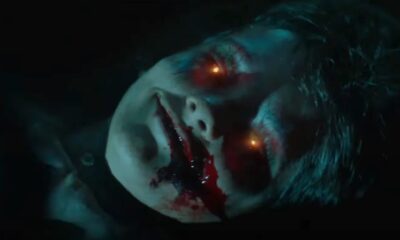
 Movies6 days ago
Movies6 days agoRenny Harlin’s Recent Horror Movie ‘Refuge’ Releasing in U.S. This Month
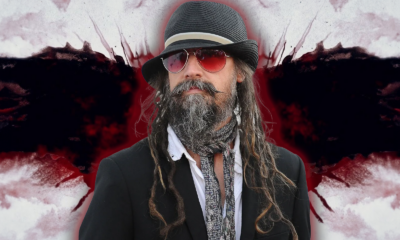

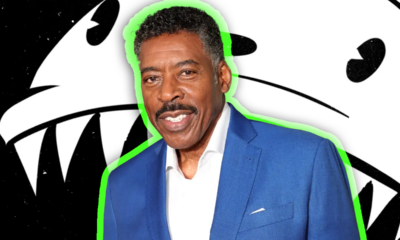

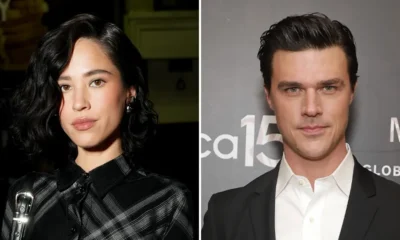


















You must be logged in to post a comment Login